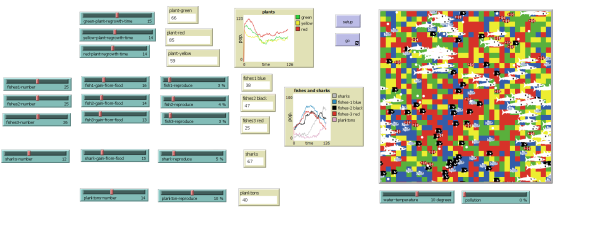Aquatic ecosystem simulation
Title: Aquatic ecosystem simulation
Author: Daria Tutynina
Method: Agent-based model
Tool: NetLogo
Contents
Introduction and problem definition
This simulation aims to replicate, in a simplified form, the intricate dynamics of marine life in the Pacific Ocean based on real-world scientific data. While the simulation is not an exact replica due to the immense complexity of marine ecosystems, it serves as a representative model. The focus lies on food webs, and interactions between species within the ecosystem. The primary goal is to explore how environmental changes impact marine populations.
Environment
The model is re
Agents
- Fishes: Inspired by real Pacific Ocean species, each with specific traits such as energy levels, reproduction rates, and movement patterns. In this simulation, three distinct types of fish are introduced, each representing different fish families: fish1 (blue), fish2 (black), and fish3 (red). Each type is associated with different feeding strategies, reflecting various fish families.
The first type, fish1 (blue), represents Generalist Herbivores. These fish have a broader dietary spectrum and can consume a wide variety of different plant species. Their feeding behavior is characterized by the ability to adapt to and consume various types of plants, making them more versatile in their herbivorous diet compared to the specialized herbivores.
ask fishes1 [ move set energy energy - 1 eat-plants fishes1 green eat-plants fishes1 yellow eat-plants fishes1 red death reproduce-fish1 ]
The second type, fish2 (black), represents Specialized Herbivores. These fish exhibit a preference for consuming a very limited range of plant species, showcasing a specialized herbivorous feeding behavior. Their diet is focused on specific types of plants, and they are adapted to extract nutrients from these particular sources.
ask fishes2 [ move set energy energy - 1 eat-plants fishes2 yellow death reproduce-fish2 ]
The third type, fish3 (red), represents Omnivorous. These fish have a diverse diet, capable of consuming both plants and plankton. Their feeding behavior is not limited to a specific food source, allowing them to feed on a mixture of plants and small aquatic organisms. The omnivorous nature of these fish makes them adaptable to different environmental conditions and food availability.
ask fishes3 [ move set energy energy - 1 eat-plants fishes3 red eat-plankton death reproduce-fish3 ]
- Sharks: Modeled after observed predatory behaviors in oceanic environments.
ask sharks [ move set energy energy - 1 eat-fishes death reproduce-sharks ]
- Plankton:
- Plants: Represented by color patches with regrowth times affected by pollution levels, mirroring real-world impacts on marine life.
Movement
Variables
- Water temperature - Influences the reproduction rates of fishes and sharks, reflecting observed correlations in the Pacific Ocean.
- Pollution - Affects the regrowth time of plants, mirroring real-world impacts on marine life.
Results
Conclusion
This simulation provides a simplified yet insightful exploration of the Pacific Ocean's marine ecosystems, drawing inspiration from real-world scientific data. The incorporation of representative data supports understanding potential impacts of environmental changes on marine populations, despite the inherent complexity of the actual ecosystems.
NetLogo File
Below I attach the source file
